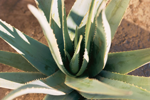Information & Articles > Aloe Vera
What is Aloe Vera?

Aloe Vera, considered through history to be ‘the miracle plant’, the aloe plant remains underestimated to the world in general. Although not miraculous, the Aloe Vera plant can have outstanding benefits for the human body; aloe vera gel contains more than 200 active ingredients, aloe is anti-inflammatory, astringent, healing, an exfoliant and has anti-ageing properties and is suitable for all types of skin.
Watch a Short Video about Forever Living Aloe Vera
Aloe Vera – The Plant
Aloe, native to Africa, is also known as “lily of the desert”, the “plant of immortality”, and the “medicine plant”. The name ‘Aloe’ was derived from the Arabic alloeh meaning “bitter” because of the bitter liquid found in the leaves. In 1500 B.C. Egyptians recorded use of the herbal aloe plant in treating burns, infections and parasites.
There are over 240 different species of Aloe, growing mainly in the dry regions of Africa, Asia, Europe and America.
Although Aloe Vera is a member of the Lily family, it is very-cactus like in its characteristics. This unique plant also belongs to a larger plant family called “Xeroids”. Of the 240+ species of Aloe, only four are recognised as being of nutritional value to humans and animals. Aloe barbadensis miller (Aloe Vera species) is considered the most effective.
When an aloe leaf is cut, a orange-yellow sap drips from the open end. As a drink this bitter sap has a very strong laxative effect. At the beginning of this century aloe was the most used raw material for laxatives in the world and although many synthetic laxatives have largely replaced it on the world market there is still a demand for this product as a raw material for laxatives. This raw material is nowadays used as basis for many other pharmaceutical products also.
The Aloe plant is about 96% water. The rest of it contains active ingredients including essential oil, amino acids, minerals, vitamins, enzymes and glycoproteins. Modern healers have used it since the 1930’s.
Benefits of Aloe Vera
Many aloe based liquid health treatments are manufactured, some combining aloe juice with other plants and herbs. The aloe gel is soothing to digestive tract irritations and aloe supplements can be used for colitis, peptic ulcers and for gastro-intestinal health.
As a food supplement, aloe is said to facilitate digestion, aid in blood and lymphatic circulation, as well as kidney, liver and gall bladder functions.
Find Out More About Aloe Vera Gel Drinks
Aloe contains at least three anti-inflammatory fatty acids that are helpful for the stomach, small intestine and colon. It naturally alkalises digestive juices to prevent overacidity – a common cause of indigestion. It helps cleanse the digestive tract by exerting a soothing, balancing effect.
A newly discovered compound in aloe, acemannan, is currently being studied for its ability to strengthen the bodies natural resistance. Studies have shown acemannan to boost T-lymphocyte cells that aid the immune system.
Extensive research since the 1930’s has shown that the clear gel of the aloe leaf has a dramatic ability to heal wounds, ulcers and burns by putting a protective coating on the affected areas and speeding up the healing rate. When the aloe leaf is broken, its gel is placed on burns to relieve pain and prevent blisters. Aloe may reduce inflammation, decrease swelling and redness, and accelerate wound healing.
One of the most popular anti-rheumatic medicines has this product as its basis.
Aloe has a moisturising effect on the skin and is a common remedy for sunburn and skin irritation. It can aid in keeping the skin supple, and has been used in the control of acne, eczema and psoriasis. It can relieve itching due to insect bites and allergies. Aloe’s healing power comes from increasing the availability of oxygen to the skin, and by increasing the synthesis and strength of tissue.
Processing Aloe Vera
Aloe vera “extract” is made by pulverising the whole leaves of the plant. Aloe juice is made from the inner leaf.
When the green skin of a leaf is removed a clear mucilaginous substance appears that contains fibres, water and the ingredients to retain the water in the leaf. These ingredients give this “gel” its special qualities as they are known now for many centuries.
Aloe must be “stabilised” within four hours of harvesting to avoid oxidation. Stabilisation is a process (involving neither heat nor chemicals that affect the Aloe’s original compounds) that assures the Aloe extract is essentially the same as if you freshly filleted the leaf yourself.

